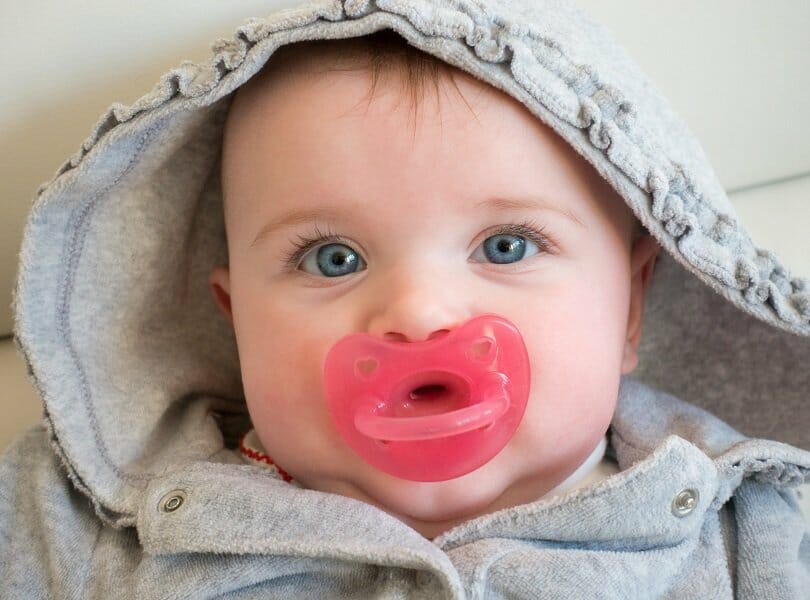Pacifiers – 5 rules

Pacifiers are one of the most universally purchased gifts for a new family expecting a baby. It’s not uncommon for the parents to be to receive upward of a dozen! There are all different sizes, shapes and colors. Some even have those cute little animals attached to them.
New parents are often confused about whether or not to give their baby a pacifier. They’ve heard stories from their friends about how their toddler or a friends toddler is still using a pacifier at 3 years old and will scream for an hour until they get it. They’ve also heard stories about babies that will cry and cry and won’t take the pacifier. So what are new parents to do?
Believe it or not there is a happy medium. Your baby can take a pacifier and not be dependent upon it. Here are 5 rules to help you and your baby maintain a nice balance with pacifiers.
Rule 1 – Before giving your baby the pacifier, make sure her or his needs are met
If your baby is hungry, the pacifier isn’t going to satisfy him or her for long. If your baby just ate 20 minutes ago and is fussing, they didn’t likely didn’t eat enough. The other reason they may fuss after only 20 minutes is that they are tired and ready to go back to sleep. A baby less than 6 weeks old will only have a few times during the day where they are awake and it isn’t for very long. Instead of giving the pacifier, offer more food. If they don’t want more food, they are very likely tired and need to go to sleep.
If a baby had had a good feed and is developmentally ready for short periods of awake time, they should be happy and content without the pacifier while they are awake.
Rule 2 – Introduce the pacifier from birth
Introducing a pacifier early is along the same lines as introducing a bottle early. When done correctly, your baby will learn to accept it with ease and not be dependent upon it or develop a preference or nipple confusion. The pacifier should only be given for short periods of time and only once or twice per day.
Rule 3 – Use pacifiers for stalling
Pacifiers are great way to help help soothe babies when you need to stall them for a few minutes. Examples would be on a car ride, while getting them dressed after a bath or in the checkout line at the grocery store These are excellent ways to use the pacifier. Trouble arises when the pacifier is given every time the baby cries. Most often this is because the baby’s needs haven’t been met and certain cues like hunger, sleep and burps have been missed.
Rule 4 – Don’t repeatedly put the pacifier back in your baby’s mouth
If your baby has spit out the pacifier or dropped it, don’t repeatedly put it back in their mouth. If you continue to do this drop and replace pattern, you will train your baby to expect the pacifier to be put back in their whenever it is dropped. Your baby will soon only be happy when they have the pacifier because they have gotten used to having it in their mouth.
Rule 5 – Don’t allow your baby to fall asleep with the pacifier routinely
If your baby gets used to sucking and soothing themself to sleep with the pacifier (or breast or bottle), this is what they learn to expect. It is normal to them and what they have learned and been taught. Try to not teach or reinforce to your baby that they get the pacifier, breast or bottle to suck to soothe for sleep. If your baby likes to suck to soothe before naps and bed, allow them to only have the pacifier before naps and at bed on occasion and for a few minutes of sucking, which is just enough to relax and get drowsy.
If you exercise caution when giving the pacifier and use it as a tool and not a prop, your baby will not develop a dependency on it. A nice happy balance will be created and you will be able to decide when to get rid of the pacifier all together.
Disclaimer:
The content contained in this blog is for informational and educational purposes only. It is not intended as medical advice or to replace the advice of any medical professional. It is based on our opinions and experience working with newborns and their families. Other’s opinions may vary. It does not represent the views of any affiliated organizations. The reader understands that term “Babynurse” is often a word used to describe a newborn caregiver. However, unless otherwise disclosed, we are not licensed nurses in any state. By reading and/or utilizing any information or suggestions contained in this blog, the reader acknowledges that we are not medical professionals and agrees to and waives any claim, known or unknown, past, present or future.
© 2018 Bishop Enterprises, LLC All Rights Reserved
